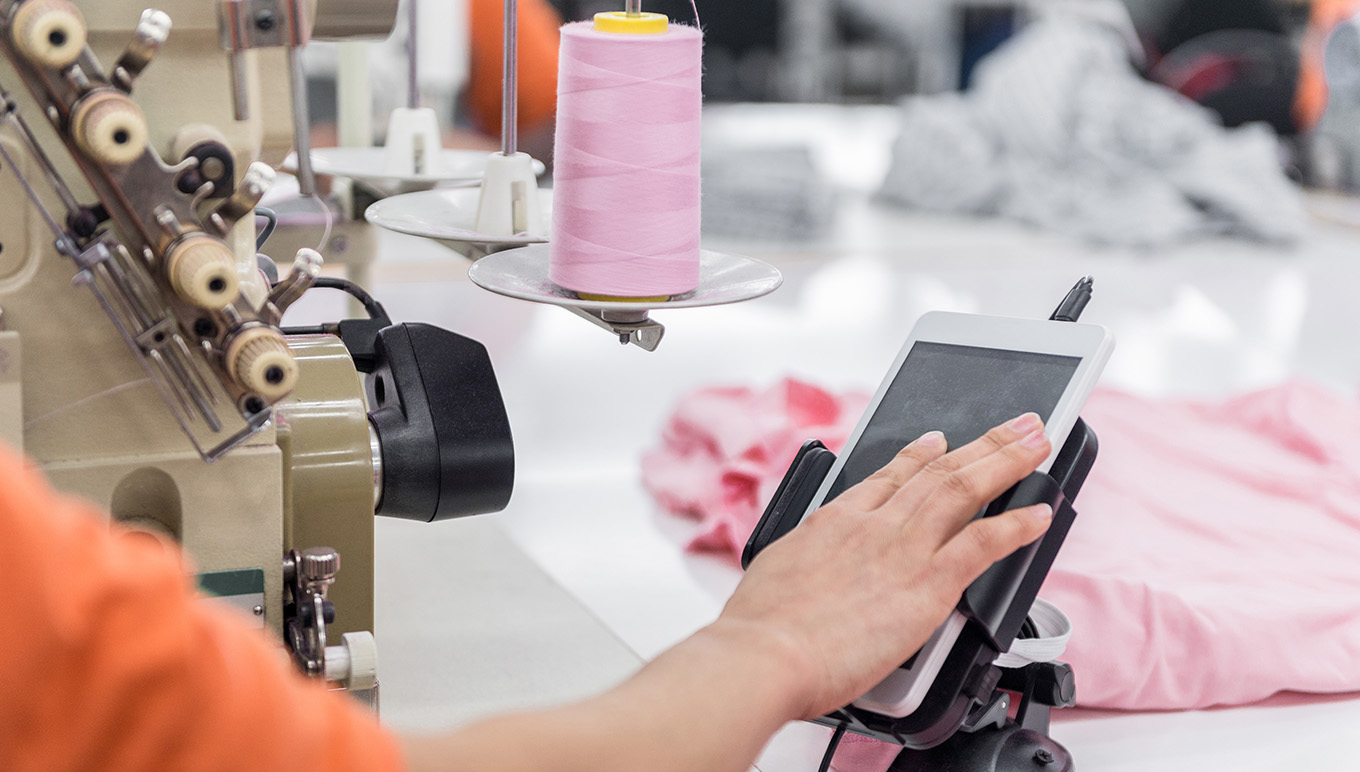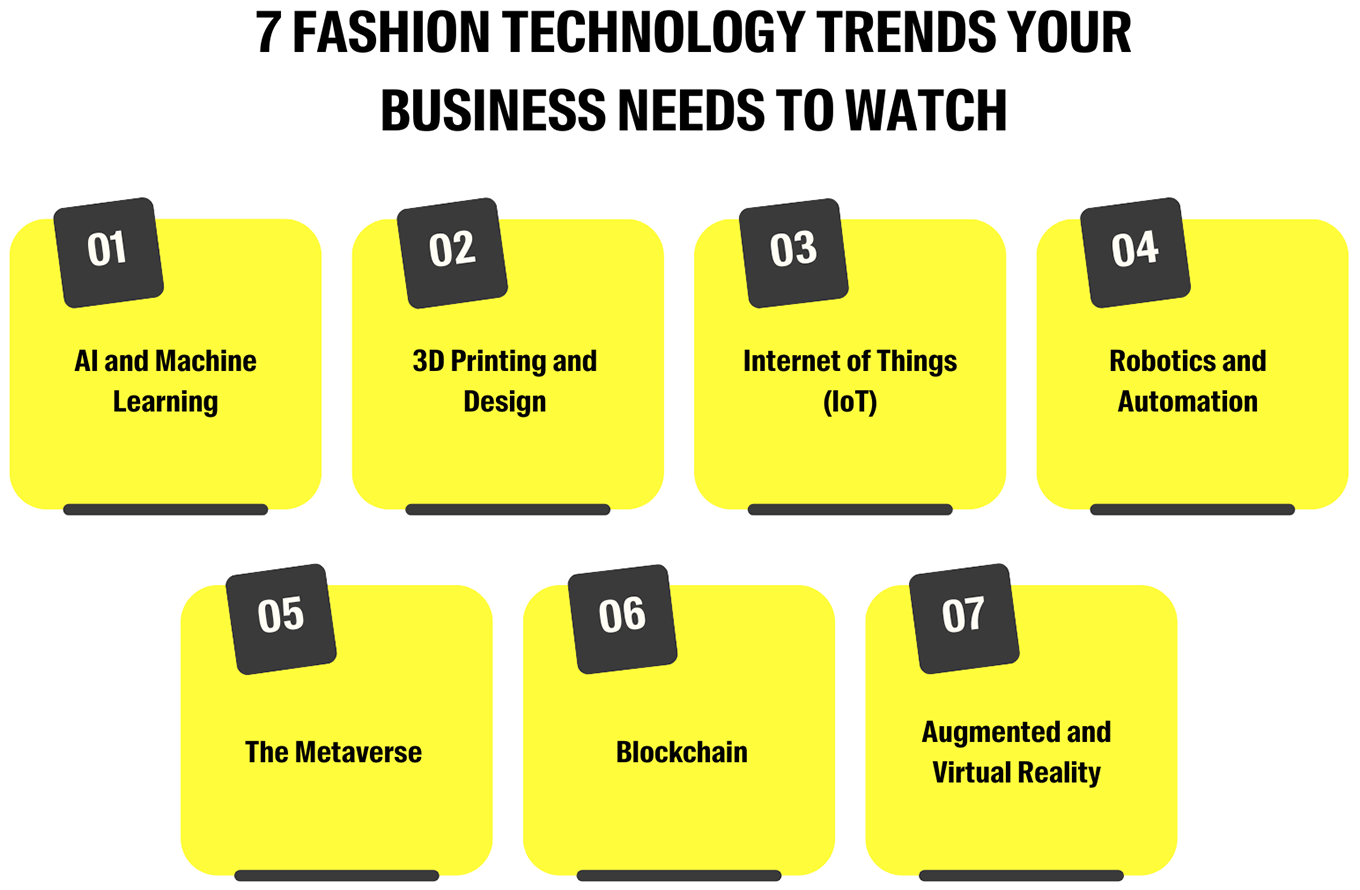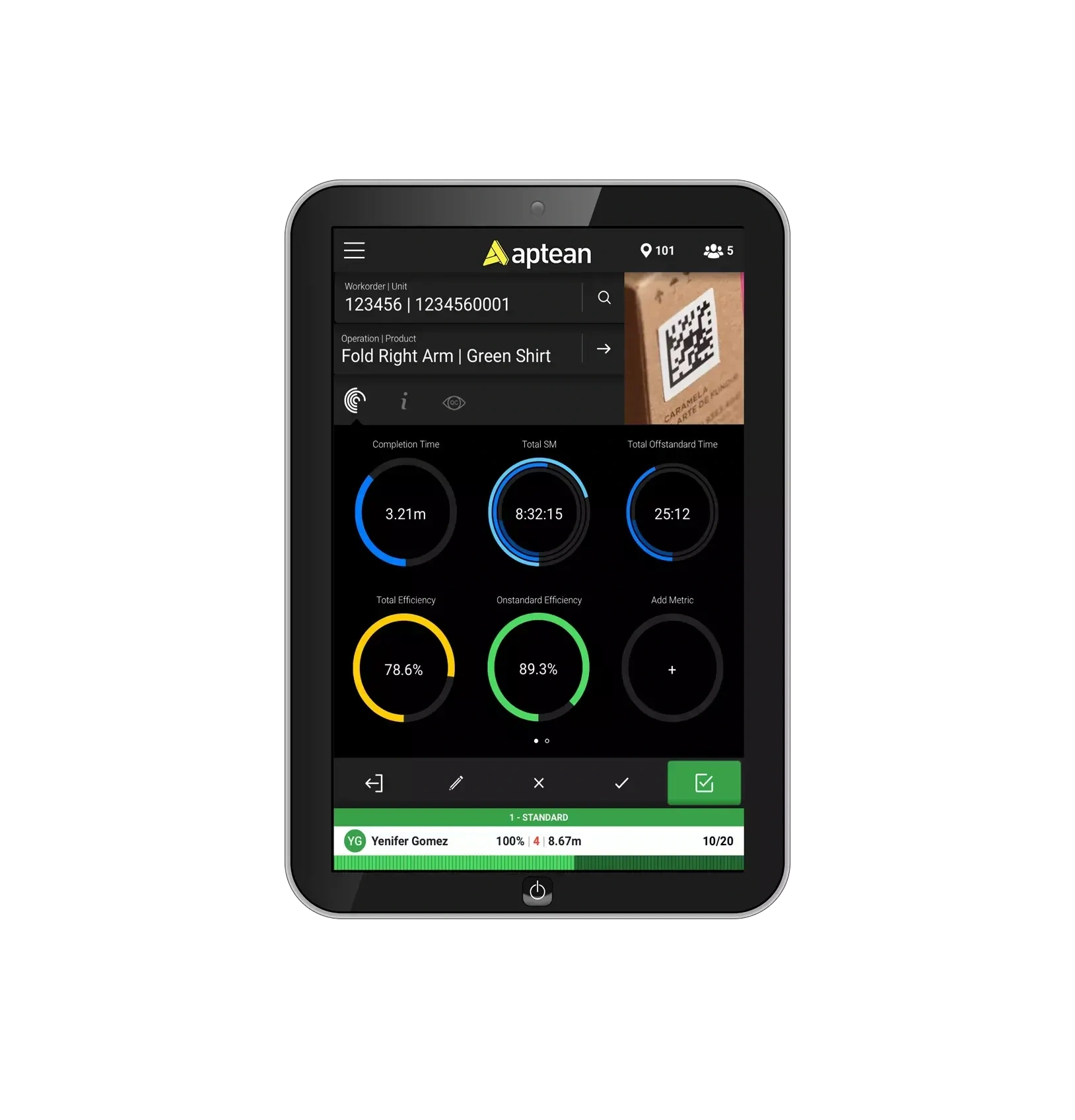Emergent Fashion Technology Trends and Why Shop Floor Control Should Be Your First Step
Emergent Fashion Technology Trends and Why Shop Floor Control Should Be Your First Step
Emergent Fashion Technology Trends and Why Shop Floor Control Should Be Your First Step
30 Jul 2024
 Aptean Staff Writer
Aptean Staff Writer Blog
Short on Time? Here’s an At-a-Glance Summary This blog explores the technologies reshaping fashion and the most practical first step to build a foundation for them. Here are the key takeaways:
Explore 7 Key Trends: The industry is being transformed by artificial intelligence (AI), 3D printing, the Internet of Things (IoT), robotics, the Metaverse, blockchain, and augmented/virtual reality.
Start With Shop Floor Control (SFC): Before investing in nascent trends, implement an apparel-specific SFC system to digitize your factory floor, which delivers immediate ROI.
Immediate Benefits: A purpose-built SFC system increases efficiency, enhances data-driven decision-making, improves productivity, reduces costs and waste.
Build on an AI-Ready Platform: For long-term success, choose a unified platform like Aptean AppCentral. It connects SFC, ERP and PLM in a single, AI-native system.

As a fashion and apparel industry professional, you know that technology is key to driving the visibility, speed and accuracy required to adapt to evolving customer demands and operational pressures. As consumer desire for sustainability, customization and innovation grow while rising costs, supply chain disruptions and legislative pressures continue, the fashion sector is turning to cutting-edge technologies to stay responsive and competitive.
In this blog, we’ll explore seven of the latest fashion technology trends—from artificial intelligence (AI) and 3D modeling to augmented reality (AR) and the Metaverse—and how they can benefit businesses like yours.
Of course, it’s not always possible for everyone to immediately implement these nascent technologies, so we’ll also discuss how an apparel-specific shop floor control (SFC) system offers help instantly improving the efficiency of your manufacturing processes; by digitizing data, reducing costs and optimizing productivity, a purpose-built SFC can free up valuable time and resources, allowing you to investigate and implement new fashion technologies.
7 Fashion Technology Trends Your Business Needs To Watch
Fashion and technology have always been intertwined, but recent advancements are pushing the boundaries like never before. From AI-driven insights for innovations to virtual platforms for marketing, technology is transforming every aspect of the fashion industry. Here’s a look at seven cutting-edge trends that are set to change the way your fashion and apparel business creates, produces and markets its products.
1. AI and Machine Learning
Over the next three to five years, generative AI could add up to $275 billion to the operating profits of apparel, fashion and luxury companies. From augmenting product ideation and aiding with high-fidelity designs to providing critical insights for improved supplier relationships and better trend analysis—the operational benefits of implementing AI can be significant.
As well as boosting internal efficiency, AI in fashion can also help you enhance the customer experience. By tracking customer journeys, AI can suggest products that match individual preferences and improve online shopping experiences. And, with all this data, it’s able to better analyze trends helping you save time and money and plan your collections more effectively—ensuring your brand always has the right products at the right time.
AI works best when it runs on connected, reliable data. That’s why a unified AI platform like Aptean AppCentral is so important. AppCentral connects your industry-specific ERP, EDI, shipping and payments systems in one secure data lake and provides powerful AI capabilities all in one platform. With this connected setup, you can use industry-specific AI agents to automate tasks, spot supply chain issues early and turn large amounts of data into easy, useful insights. Instead of basic reporting, you get proactive improvements and predictive intelligence. In other words, AI takes care of routine work while your team focuses on growth.
AI adoption in fashion is growing fast with major brands and smaller organizations alike already using AI-powered tools. So, there’s no time to delay. If AI anxiety is holding you back, or you’re cautious about adoption challenges, starting with a trusted vendor that offers AI tools alongside must-have apparel software is an easy way to get started.
2. 3D Printing and Design
With traditional methods, significant amounts of fabric often go to waste during cutting and production. 3D printing, however, eliminates this waste almost entirely. Clothes are printed on demand, meaning only the amount of material needed is used. In addition, 3D printing can cut material costs and reduce energy consumption, making it a much more eco-friendly alternative.
Possibly the most exciting aspect of 3D-printed clothing is the level of customization it offers. Unlike traditional manufacturing with pre-set sizes, 3D printing allows your fashion brand to more efficiently produce garments tailored exactly to a customer's specifications—enabling a more personalized service that can differentiate your brand.
Your fashion designers can also use 3D printing technology to create prototypes that help them assess different designs, saving time and assisting them in developing innovative, but viable products.
Meanwhile, 3D modeling technology may even enable your designers to ditch prototypes altogether. By replacing traditional 2D tech packs with highly detailed 3D designs, your brand can reduce sample-making costs, streamline collaboration between teams and speed up time-to-market.
3. Internet of Things (IoT)
The Internet of Things (IoT) connects everyday objects to the internet, allowing for data sharing, improved efficiency and better customer experiences. The fashion industry has already entered the IoT space to meet the demands of modern life with wearable tech and clothing with digital capabilities becoming increasingly common. These "smart" clothing and accessories can track health data, improve comfort and even incorporate lighting or heating.
Innovative brands like Prevayl SmartWear have already made use of IoT to develop apparel with built-in sensors that monitor heart rate and athletic performance, blurring the lines between fashion and fitness trackers. While sportwear brand Nike has launched its first smart shoe, “Adapt BB,” and tech giants Samsung and Apple are all set to compete with less household names like Oura over smart ring wearables. Remember when Fitbit controlled 40% of the wearables industry in 2015? Continue to watch this market heat up.
Beyond these more established applications of IoT in apparel, it can also be used to help your fashion brand be more sustainable. By using IoT connected smart devices and sensors within your production, you can monitor resource consumption, identify inefficiencies and reduce waste. With the help of IoT, your team can access real-time data on inventory levels, improve supply chain and optimize production.
4. Robotics and Automation
Robotics and automation are optimizing the fashion industry by streamlining various manufacturing processes and reducing human labor dependency. Your fashion brand can utilize robots and automation in production via sewing activities, fabric inspection, spreading and cutting, warehousing and even distribution. This technological integration offers you higher production rates, improved product quality and enhanced cost efficiency.
For example, robotic sewing technologies are transforming garment manufacturing. Robots like Sewbo and LOWRY SewBot by Software Automation can handle fabric during sewing activities, enabling your skilled workers to focus on more complex tasks.
When it comes to automation, the possibilities span your entire end-to-end operation. The fabric inspection process, which was traditionally performed manually, leading to inconsistencies and undetected defects, can be significantly improved by automation. Now, specialized tools and equipment can help your production team precisely identify fabric defects, automatically reject defective fabric lots and ensure higher-quality materials proceed to production.
A variety of apparel software solutions also offer automations to streamline your fashion operations, such as product lifecycle management (PLM) that optimizes new product development (NPD) and enterprise resource planning (ERP) software to unify data and streamline end-to-end processes.
5. The Metaverse
Metaverse refers to a digital realm that merges the physical and virtual worlds. Your fashion brand can leverage this technology to provide more immersive experiences, engage with customers in novel ways and generate a new revenue stream. This new technology allows your organization to showcase pure creativity even if it defies gravity, ignoring material limitations. In a nutshell, the metaverse offers opportunities that can reshape how fashion is presented and consumed.
Virtual fashion, encompassing digital garments and accessories, is created using 3D design software, augmented reality (AR) or AI. These digital items can be traded as non-fungible tokens (NFTs) on a blockchain, ensuring their uniqueness and authenticity.
Meanwhile, virtual fashion shows in the metaverse allow your brand to showcase its collections to a global audience without the logistical constraints of physical events. These digital runway events are cost-effective and inclusive, providing real-time engagement opportunities for customers worldwide.
The metaverse is also transforming marketing strategies for fashion brands. Businesses are able to develop immersive and interactive experiences tailored to the metaverse's unique characteristics. With advanced technologies, new skills and a deep understanding of the digital world's dynamics, you can engage with consumers innovatively and remain competitive in the evolving market.
6. Blockchain
Known for being a decentralized, distributed, secure ledger that stores verified transaction information in blocks, integrating blockchain technology in the fashion industry will address various challenges, from counterfeiting to supply chain transparency.
Blockchain creates an immutable record of a product's journey. Every time a product is bought or sold, a record is added to a secure digital log, documenting its entire history. This allows the buyers to confirm your product's authenticity and avoid any issues related to fakes or stolen goods, as the records are tamper-proof. Major luxury fashion brands, such as Louis Vuitton, Prada and Kering, are already using blockchain to track merchandise and prove authenticity to combat counterfeiting.
As you know, consumer demand for sustainable and eco-friendly products has increased across industries, making supply chain transparency crucial. Blockchain technology allows your brand to create a digital record of every transaction, invoice and communication along your fashion supply chain. Blockchain technology's transparency enhances consumer trust by providing verifiable information about product authenticity, sustainability and ethical practices.
7. Augmented and Virtual Reality
Innovators in the industry are predicting that augmented and virtual reality (VR) technologies will attract even the most reluctant shoppers, while dedicated fashion enthusiasts will find even more joy in their shopping experiences. According to a Deloitte report, 71% of shoppers indicate that they would probably shop more often with the use of AR-powered apps.
Augmented reality enhances the real world by using technology to overlay digital elements like visuals and sounds whereas virtual reality offers a simulated experience that can either mimic or completely differ from the real world.
Instead of spending hours in malls, your customers can use AR and VR for in-store navigation, interactive display screens, virtual try-ons and virtual fitting rooms. These technologies streamline the shopping process, making it more efficient and enjoyable.
AR and VR can also significantly improve the customer experience by offering innovative solutions like virtual tailors and virtual makeovers. Virtual makeovers allow customers to experiment with different styles, makeup and accessories digitally. These provide a personalized and engaging shopping experience, attracting customers and encouraging them to spend more time in-store.

Shop Floor Control Software: Fashion Technology To Transform Your Business Today
Some of these fashion technology trends are experiencing widespread adoption while others are still emerging—and likely to see a slower rollout across the industry. But, whether your business is ready to jump on these latest trends or not, there is a solution that you can implement right now—shop floor control software.
Offering a solid digital foundation, allowing you to better harness the potential of new innovations and trends as they emerge, Aptean Shop Floor Control is a manufacturing execution system (MES) that monitors, tracks and optimizes production activities helping you master factory floor execution. It provides real-time visibility into your manufacturing process, enabling efficient scheduling, resource allocation and quality control. SFC helps fashion manufacturers streamline operations, reduce downtime and improve overall productivity.
Implementing shop floor control offers many advantages for your fashion business, leading to significant improvements across various aspects of production. Here's a breakdown of some of the aforementioned key benefits:
1. Increased Efficiency
Through real-time monitoring, a fashion and apparel shop floor control system detects and resolves potential issues, like quality discrepancies and product defects that can cause delays. Employees can also scan barcodes on pieces or garments rather than writing everything down in a notebook or using gum sheets—resulting in an immediate efficiency improvement.
2. Enhanced Decision-Making
A shop floor control system offers your team real-time data on production operations for performance analysis. This empowers you to increase forecasting accuracy by 85% and make well-informed strategic decisions that can help you drive profitability.
3. Improve Productivity
Shop floor control software promotes efficient workforce management with time, attendance and worker performance features, minimizing idle time and reducing the need for overtime. In addition, by providing real-time insights and alerts, an SFC system helps your managers quickly identify and address issues, reduce downtime and improve overall productivity by up to 55%.
4. Reduced Costs and Waste
As well as reducing downtime costs, an apparel SFC system facilitates effective inventory management with optimal material use, leading to lower production costs and less waste.
5. Quality Control
Shop floor control software enhances quality control by providing real-time data on defects and repairs, enabling your workers and supervisors to address issues promptly. You can use this data to refine quality processes and reduce the need for repairs and rework.

Transform Your Fashion Business With Aptean Software Systems
As we’ve explored, the integration of advanced technologies in the fashion industry is crucial for driving innovation and staying competitive. From AI and 3D printing to IoT devices and the Metaverse, these trends are transforming how fashion businesses operate, creating new opportunities for growth and efficiency.
However, it's crucial to recognize that it's not only the latest popular trends that can create significant change in your business. Implementing apparel and fashion software systems like shop floor control, enterprise resource planning and product lifecycle management can deliver tangible benefits quickly, helping your business feel confident in making impactful decisions now.
And, when you choose best-in-class systems from vendors that are constantly innovating, you can even leverage some of the latest technologies in your existing processes. Aptean's AppCentral platform integrates your ERP, PLM and other fashion systems into a single, AI-powered environment. This creates a connected digital ecosystem where data, workflows and AI insights flow seamlessly, making it easier for your business to operate efficiently and adapt quickly.
Ultimately, the goal is not just to adopt new technologies, but to create a smarter, more responsive operation. AppCentral delivers this by embedding AI directly into your daily workflows. Imagine AI agents that automatically optimize production schedules based on real-time material availability, or intelligent assistants that proactively monitor material use across your facilities to reduce costs. This is the power of a platform where AI is woven into every layer, working for you in the background to prevent problems and capitalize on opportunities.
With Aptean, you gain a strategic partner, not just a software vendor. Our experts work with you to configure these AI-driven workflows, ensuring you see immediate value and a rapid return on your investment, setting your brand apart in a competitive market.
Take the next step towards innovation and efficiency with our fashion and apparel software systems. Contact us today to learn more or request a personalized demo.
Klaar om uw bedrijf naar een hoger niveau te tillen?
We hebben gespecialiseerde MES-oplossingen waarmee u elke uitdaging in uw branche aankunt.



